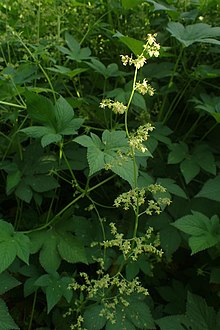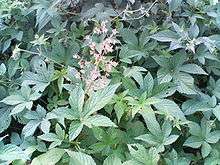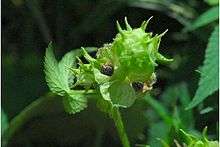Humulus japonicus
Humulus japonicus, known as Japanese hop, synonym H. scandens, is an ornamental plant in the family Cannabaceae.
| Humulus japonicus | |
|---|---|
 | |
| Scientific classification | |
| Kingdom: | Plantae |
| Clade: | Tracheophytes |
| Clade: | Angiosperms |
| Clade: | Eudicots |
| Clade: | Rosids |
| Order: | Rosales |
| Family: | Cannabaceae |
| Genus: | Humulus |
| Species: | H. japonicus |
| Binomial name | |
| Humulus japonicus | |
Originally native to East Asian countries such as China, Japan, Korea, and extending its habitat to Vietnam, it was imported to North America in the late 19th century as an ornamental. Since its arrival in North America, it has spread widely. It can be found throughout the Northeastern U.S. and eastern Canada, and considered an invasive species in North America.
Nomenclature
Humulus japonicus (syn. H. scandens, Antidesma scandens) is known by the common name of "Japanese hop",[1][2] or "wild hop".[3]
The plant is called lü cao (葎草) in Mandarin Chinese, and kanamugura (カナムグラ) in Japanese.[4]
Description


Well-developed leaves with 5-9 lobes; abaxial surfaces of leaves pubescent, but not densely so; infructescence rarely longer than 2 cm, with bracts and bracteoles less than 1 cm long, and notable spinulose-ciliate[5] Inflorescences: staminate inflorescences erect, 15–25 cm, flower anthers without glands; pistillate inflorescences spikes, conelike, ovoid; bracteole ovate-orbiculate, 7–10 mm, pilose, margins densely ciliate-hairy. Infructescences pendulous, green, conelike, ovoid to oblong, (1-)1.5-3(-4) cm; bracteoles without yellow glands.[6]
Dispersal
Seeds germinate in early spring, but plants may continue to emerge if conditions are favorable. Seeds can be dispersed by number of agents including humans, animals, machines, and flood waters.[7]
Distribution and habitat
Humulus japonicus is native temperate parts of Asia (China, Japan, Korea, Taiwan and the Russian Far East) and the tropical environment of Vietnam and Laos,[7][1] but has become an invasive species in North America since it was imported in the late 19th century.[8]
The plant has been immensely successful in North America, and is found throughout eastern Canada and the eastern half of the United States, and considered a invasive species.[9] In the United States Humulus japonicus has a lateral range from Nebraska/North Dakota to Maine and a vertical range from Minnesota to Georgia.[7][10]
Japanese hops grow well given plentiful sunlight, moisture, and nutrient rich soil, and are most commonly found along stream banks and floodplains.[7] Japanese hops do not grow as well in shaded areas and drier soils.[7] In milder climates, it can survive the winter.[7]
Economic uses
The plant was introduced into America in the 19th century both as an ornamental and raw ingredient for the Asian tonic.[7] In traditional Chinese medicine this herb known as lü cao is used rather uncommonly, with supposed diuretic and heat-cooling effects.[11][12]
Although related to the common hop Humulus lupulus, whose cultivars are the brewer's hop used in beer production, the Japanese hop is found to be deficient in the bitter acids and essential oils used for flavoring beer, being devoid of lupulin glands (or producing very few resin glands[13]); hence the Japanese hop is not considered viable for use in brewing.[7][14][8][lower-alpha 1]
Natural enemies
This species is a host plant for the butterfly Polygonia c-aureum, the Asian comma, hence in China the butterfly is considered a major pest affecting the cash crop used in medicine.[16]
Ecological threat
The Japanese hop can adapt well to new environments. Its range and distribution in North America prove that it can thrive in a wide range of environments, from the southern regions of the U.S. to the far reaches of northern Canada. It can grow and cover any area quickly. Thousands of hop plants can grow in one acre, and they can blanket a majority of the local vegetation.[7] The vines grow rapidly during the summer, climbing up and over everything in their path, and can form dense mats several feet deep, blocking light to whatever plants are underneath.[7]
Explanatory notes
- There are just three species of hop, H. luplulus, H. japonicus and H. yunnanensis.[15]
References
- Citations
- Zeng, Xianfeng; Ma, Jinshuang (November 2009), "(1914) Proposal to Reject the Name Antidesma scandens (Humulus scandens) (Cannabaceae)", Taxon, 58 (4): 1372–1373, JSTOR 27757029CS1 maint: ref=harv (link)
- "BSBI List 2007". Botanical Society of Britain and Ireland. Archived from the original (xls) on 2015-01-25. Retrieved 2014-10-17.
- English Names for Korean Native Plants (PDF). Pocheon: Korea National Arboretum. 2015. p. 491. ISBN 978-89-97450-98-5. Archived from the original (PDF) on 25 May 2017. Retrieved 4 January 2017 – via Korea Forest Service.
- Wiersema, John H.; León, Blanca (2016). Humulus japonicus Siebold & Zucc. World Economic Plants: A Standard Reference (2nd ed.). CRC Press. p. 355. ISBN 1466576812.CS1 maint: ref=harv (link)
- Small, Ernest (Spring 1978). "A Numerical and Nomenclatural Analysis of Morpho-geographic Taxa of Humulus". Systematic Botany. American Society of Plant Taxonomists. 3 (1): 37–76. doi:10.2307/2418532. JSTOR 2418532.
- "Humulus japonicus in Flora of North America @ efloras.org". www.efloras.org. Retrieved 2015-12-07.
- "Japanese Hop (Humulus japonicus)". www.nps.gov. Archived from the original on 2013-07-31. Retrieved 2015-12-07.
- Balogh, Lajos; Dancza, István (2008), "Humulus japonicus, an emerging invader in Hungary" (PDF), Plant invasions: human perceptions, ecological impacts and management, Leiden: Backhuys, p. 73CS1 maint: ref=harv (link)
- "Humulus scandens (Humulus japonicus) Japanese hop" (PDF). Center for Invasive Species and Ecological Health. Archived from the original (PDF) on 3 March 2016. Retrieved 7 October 2015.
- "Plants Profile for Humulus japonicus (Japanese hop)". plants.usda.gov. Retrieved 2015-12-07.
- Neeb, Gunter R. (2007). Blood Stasis: China's Classical Concept in Modern Medicine. Elsevier Health Sciences. p. 162. ISBN 044310185X.CS1 maint: ref=harv (link)
- Yang, Xinrong; Chen, Anmin; Ma, Yingfu; Gao, Yuan; Wan, Shuqian, eds. (2013). Japanese Hop Herb. Encyclopedic Reference of Traditional Chinese Medicine. Fu Bingyi; Sun Fang; Qiao Jinlin; Li Quan; Wan Shuqian; Hermut Werner; Chuang Yinfu; Zhu Xinsheng (revised ed.). Springer Science & Business Media. p. 324. ISBN 366205177X.CS1 maint: ref=harv (link)
- Verzele, M.; De Keukeleire, D. (2013). Chemistry and Analysis of Hop and Beer Bitter Acids (revised ed.). Elsevier. p. 2. ISBN 1483290867.CS1 maint: ref=harv (link)
- Alfred, Haunold (1980). "27 Hop". In Fehr, Walter R.; Hadley, Henry H. (eds.). Hybridization of Crop Plants. Wiley. doi:10.2135/1980.hybridizationofcrops.c27. ISBN 9780891185666.CS1 maint: ref=harv (link)
- Li, Q.; Wang, J.; Liu, C. (2016), "12 Beer", in Pandey, Ashok; Du, Guocheng; Sanromán, Maria Ángeles; Soccol, Carlos Ricardo; Wan, Shuqian (eds.), Current Developments in Biotechnology and Bioengineering: Food and Beverages Industry, Elsevier, p. 162, ISBN 0444636773CS1 maint: ref=harv (link)
- Shen, Rongwu; Wang, Jianguo; Zhan, Ganxiang (1991). Studies on the Biology of Polygonia c-aurem Linnaeus. Acta Agriculturae Universitis Jiangxiensis. 1. p. 3.CS1 maint: ref=harv (link)
External links
| Wikimedia Commons has media related to Humulus japonicus. |